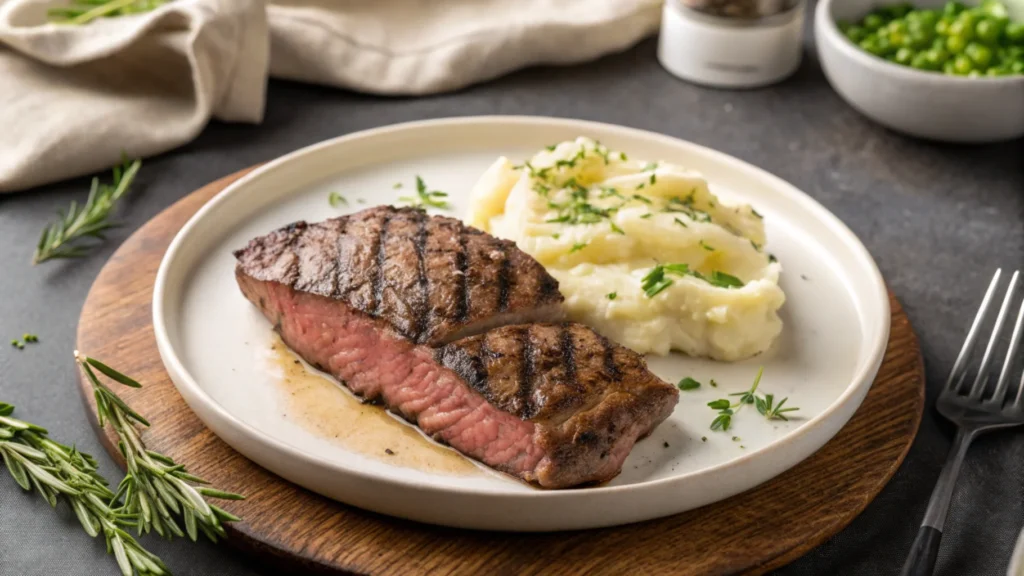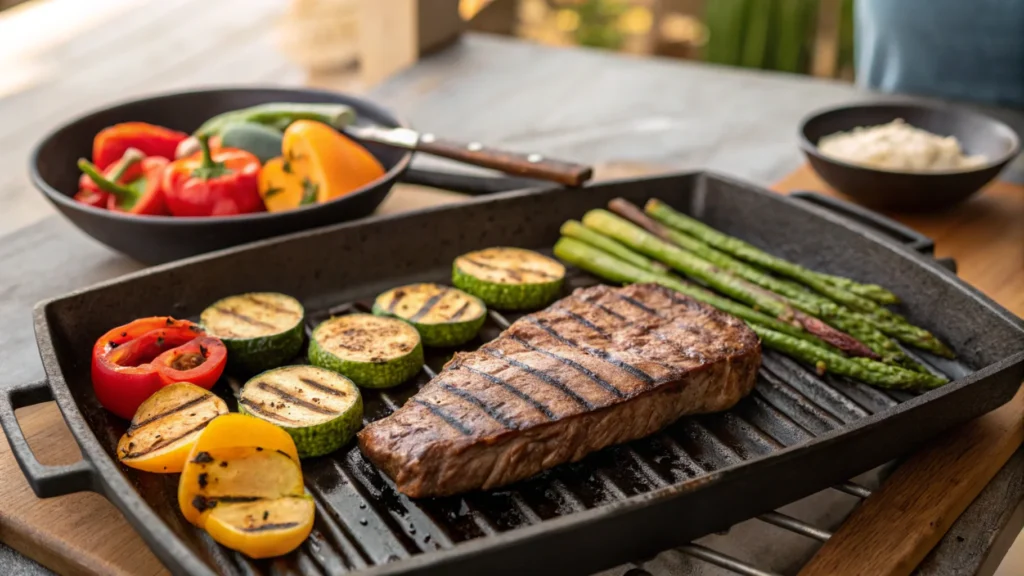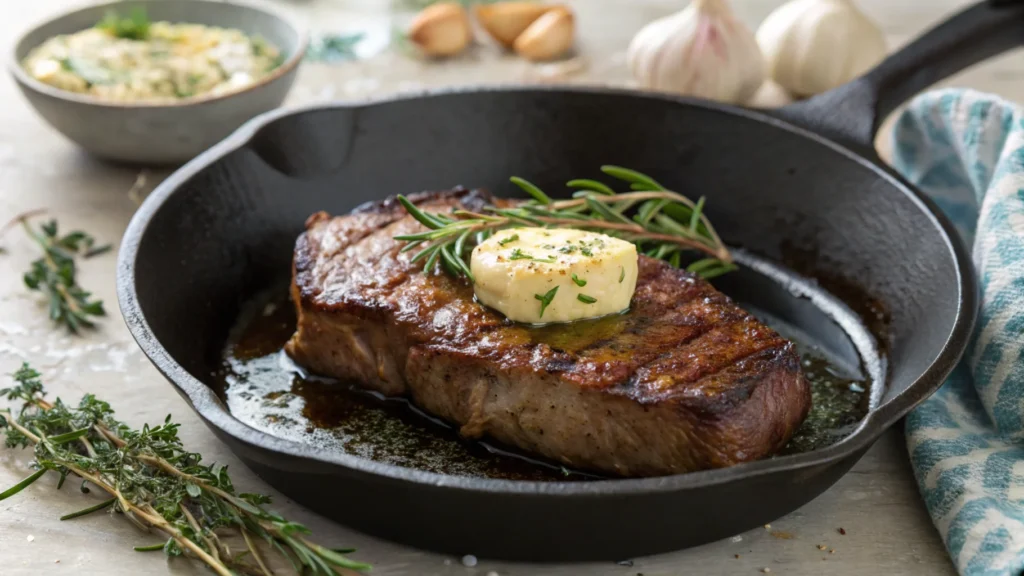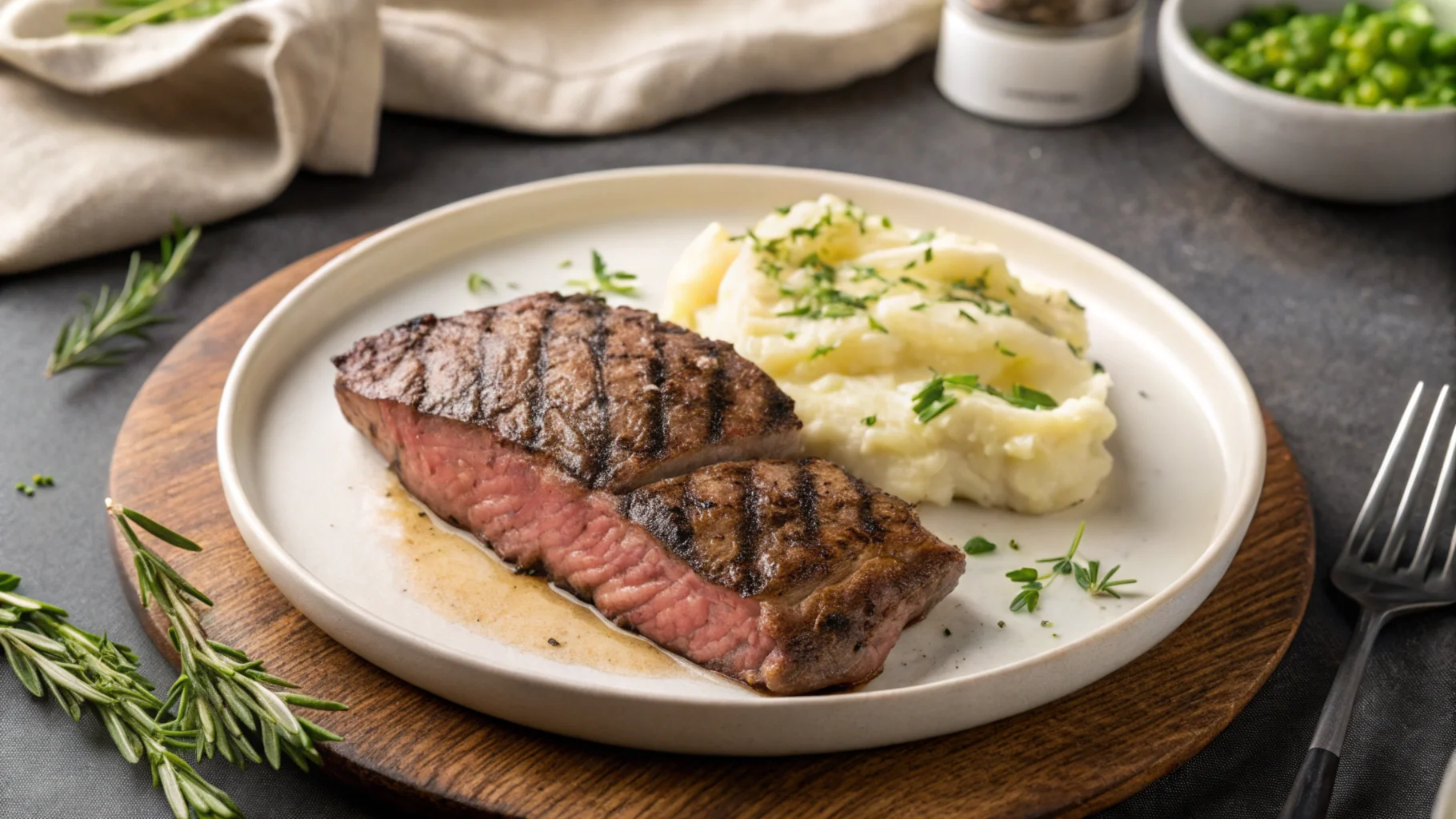Flat iron steak, often regarded as the best steak for grilling, is gaining popularity for its exceptional flavor and affordability. This tender cut, taken from the cow’s shoulder, is naturally soft due to its underworked muscle. It’s a versatile option, perfect for grilling, pan-searing, or sous-vide, making it a great choice for those seeking a rich and satisfying steak experience without overspending on cuts like ribeye or filet mignon.
To enhance your meal preparation and storage, consider exploring tips like can I freeze cooked chicken thighs?. These insights can help maintain the freshness and safety of your dishes while maximizing efficiency in the kitchen.

Table of Contents
Understanding the Flavor and Texture of Flat Iron Steak
The flat iron steak, often praised as the best steak for grilling, combines bold flavor with remarkable tenderness. Its robust, beefy taste rivals pricier cuts like ribeye, while its finer grain ensures a tender and juicy bite. With balanced marbling, it offers just the right amount of fat for a flavorful and satisfying experience without being overly greasy. This cut is ideal for grilling, pan-searing, or other methods, consistently delivering a restaurant-quality meal.
If you’re exploring other meal ideas, chicken thighs are an excellent and versatile option. Discover what meals can be made from chicken thighs to expand your recipe repertoire with delicious and practical dishes.
Comparing Flat Iron Steak to Other Cuts
You may wonder, “Is flat iron a good cut of steak?” To answer that, it’s important to compare it to other well-known cuts of beef. When placed alongside steaks like ribeye, sirloin, or filet mignon, flat iron holds its own in several key areas.
- Ribeye vs. Flat Iron: Ribeye is known for its high marbling, which enhances its juiciness and flavor. In contrast, flat iron is leaner but still offers great tenderness and flavor. Flat iron is often less expensive than ribeye, making it an attractive option for budget-conscious steak lovers.
- Filet Mignon vs. Flat Iron: Filet mignon is famed for its melt-in-your-mouth tenderness, but it lacks the intense beefy flavor of this cut. While filet mignon can be a bit too lean for some, this option strikes a good balance between tenderness and flavor, making it a versatile choice.
- Sirloin vs. Flat Iron: Sirloin steak is lean and flavorful but tends to be tougher than the best steak for grilling, which stays juicy and tender when cooked properly. Its marbling ensures juiciness, unlike sirloin, which needs marinating or careful cooking.
Ultimately, flat iron steak may not be as luxurious as some of the pricier cuts, but it offers excellent value for those who appreciate both tenderness and flavor.
Nutritional Value of Flat Iron Steak
Flat iron steak offers a wealth of nutritional benefits, making it a great choice for those looking to boost their protein intake without consuming excessive fat. Here’s a breakdown of the key nutrients found in a 3-ounce serving of flat iron steak:
- Calories: Approximately 200-250 calories, depending on the cooking method
- Protein: Around 22 grams of high-quality protein
- Fat: 10-15 grams, with a good balance of monounsaturated and saturated fats
- Iron: A significant source of iron, which is essential for maintaining healthy blood cells
- Zinc: This cut also contains zinc, which is important for immune function.
As part of a balanced diet, flat iron steak can help support muscle growth and repair, making it ideal for athletes or anyone looking to maintain a healthy lifestyle. Additionally, the rich iron content supports overall health by promoting oxygen transport in the blood.
Selecting the Perfect Flat Iron Steak
When shopping for flat iron steak, there are several factors to consider in order to select the perfect cut. To ensure you get the best possible steak, pay attention to the following:
- Look for marbling: Marbling refers to the thin strands of fat within the meat. It enhances both flavor and tenderness, so a cut with visible marbling is typically a good sign.
- Check the color: Fresh cuts should be a bright, deep red. Avoid pieces that appear brown or have a dull color, as this could indicate aging or improper storage.
- Thickness matters: Flat iron steaks come in varying thicknesses. For a more tender steak, look for a cut that is at least 1 inch thick.
- Freshness: If possible, buy from a trusted butcher who can provide fresh cuts. This ensures you’re getting a high-quality steak.
By choosing the right flat iron steak, you’ll maximize the flavor and tenderness, ensuring your meal is a success.
Best Cooking Methods for Flat Iron Steak
The flat iron steak is remarkably versatile and can be cooked in numerous ways. The most popular methods include grilling, pan-searing, and sous vide. Regardless of the technique you choose, there are a few key principles to follow in order to achieve the best results.
Best Ways to Prepare Flat Iron Steak
Before cooking, it’s crucial to properly prepare the flat iron steak. Start by removing the steak from the fridge about 30 minutes before cooking, allowing it to come to room temperature. This step ensures the meat cooks more evenly. Season generously with salt and pepper, or marinate for extra flavor.
Furthermore, make sure to preheat your cooking surface to a high temperature, whether you’re using a grill, cast-iron skillet, or another tool. This will help to create a beautifully seared exterior while keeping the interior tender.
Grilling Techniques
Grilling is a classic method for cooking flat iron steak. To get the best results, follow these tips:
- Preheat your grill to medium-high heat.
- Place the steak directly on the grill and cook for 4-6 minutes per side for medium-rare doneness.
- Allow the steak to rest for 5-10 minutes before slicing to retain the juices.
Grilling imparts a distinct smoky flavor that enhances the natural taste of this cut, making it a favorite among steak enthusiasts.

Pan-Seared Flat Iron Steak Recipe
Pan-searing is another great way to cook this cut, especially when you don’t have access to a grill. For this method, follow these steps:
- Heat a tablespoon of vegetable oil in a large cast-iron skillet over high heat.
- Season the steak with salt, pepper, and any desired herbs or spices.
- Place the steak in the skillet and sear for about 4 minutes per side.
- Lower the heat and add a pat of butter, garlic, and rosemary for extra flavor.
- Let the steak rest for 5-10 minutes before slicing.
This method creates a crispy crust while locking in the juices, producing a tender and flavorful steak.

Sous Vide for Perfect Results
Sous vide is a method that involves cooking the steak in a vacuum-sealed bag at a precise temperature for an extended period of time. This results in a steak that is evenly cooked from edge to edge. For flat iron steak, follow these steps:
- Preheat your sous vide water bath to 130°F (for medium-rare).
- Season the steak and seal it in a vacuum bag.
- Submerge the bag in the water bath and cook for 1-2 hours.
- Remove the steak and sear it quickly in a hot skillet for a golden crust.
Sous vide cooking ensures the steak is tender and juicy, offering an almost foolproof way to prepare this cut.
Seasoning and Marinades for Flat Iron Steak
While flat iron steak has an impressive natural flavor, seasoning and marinades can elevate the taste even further. Simple seasonings like salt and pepper always work well, but you can create more complex flavor profiles with various marinades.
- Classic Steak Marinade: A mix of olive oil, garlic, soy sauce, Worcestershire sauce, and a dash of lemon juice will tenderize the steak while infusing it with savory flavors.
- Herb and Garlic Marinade: Fresh herbs like rosemary and thyme, along with garlic and olive oil, make for a fragrant and aromatic marinade.
- Spicy Marinade: For those who enjoy a kick, a combination of chili flakes, paprika, and cumin can spice up your flat iron steak.
Allow the steak to marinate for at least 30 minutes, or ideally a few hours, to fully absorb the flavors.
Serving Suggestions and Side Dish Pairings
Flat iron steak pairs wonderfully with a variety of side dishes, making it a great option for a complete meal. Consider the following pairings:
- Grilled Vegetables: A medley of grilled vegetables such as asparagus, zucchini, or bell peppers adds a healthy balance to the richness of the steak.
- Garlic Mashed Potatoes: Creamy mashed potatoes infused with garlic complement the richness of this cut.
- Salad: A fresh green salad with a tangy vinaigrette provides a refreshing contrast to the hearty steak.
These pairings ensure a well-rounded meal that enhances the steak’s natural flavors, making it the best steak for grilling to enjoy with a variety of side dishes.
Common Questions About This Cut of Steak
Is flat iron a good cut of steak?
Yes, the flat iron offers a fantastic balance of tenderness, flavor, and affordability. Many consider it one of the best-value cuts from the shoulder area of the cow.Many steak lovers appreciate its versatility in cooking methods and its robust flavor.
How do I cook flat iron steak?
Flat iron steak can be cooked through various methods, such as grilling, pan-searing, or sous vide. It’s important to season it well and choose a cooking technique that best suits your taste preferences.
Is flat iron steak tender?
Yes, flat iron steak is known for its tenderness, especially when cooked correctly. It comes from a well-exercised muscle, which makes it flavorful and tender compared to many other cuts from the shoulder.
FAQs
Is Flat Iron Steak Good Quality?
Yes, this cut is considered a high-quality piece of beef, especially for its price. While it may not be as luxurious as cuts like filet mignon or ribeye, it offers excellent tenderness, a robust flavor, and great marbling. This cut is derived from the shoulder of the cow, where the muscle is not overworked, contributing to its soft texture. When cooked properly, it rivals more expensive cuts in both flavor and tenderness, making it an excellent choice for those seeking quality without the hefty price tag. In fact, it’s often regarded as the best steak for grilling, delivering both flavor and value in every bite.
Which Is Better, Ribeye or Flat Iron?
Both ribeye and flat iron have their unique qualities, making them appealing in different ways. Here’s how they compare:
- Ribeye: Known for its rich marbling and exceptional tenderness, ribeye offers an intensely juicy and flavorful experience. However, it’s also higher in fat content, which makes it richer but also more expensive.
- Flat Iron: While slightly leaner than ribeye, flat iron still delivers a juicy, tender, and flavorful experience at a more affordable price. It’s versatile in cooking methods and is less fatty than ribeye, which may appeal to those who prefer a less greasy steak.
In summary, if you’re looking for a more indulgent experience and are willing to spend more, ribeye is the winner. However, if you prefer a budget-friendly steak that still provides great flavor and tenderness, this cut is an excellent choice.
Can Flat Iron Steak Be Tender?
Yes, this cut is naturally tender, particularly when properly cooked. It comes from the shoulder of the cow, which is a well-exercised muscle that tends to be leaner but still maintains excellent tenderness. The key to maximizing its tenderness is proper preparation and cooking techniques. When cooked to medium-rare or medium doneness, this cut retains its juicy and tender qualities. Additionally, resting the steak after cooking helps redistribute the juices, ensuring a moist, tender bite.
What Steak Is Better, Sirloin or Flat Iron?
When comparing sirloin and flat iron steak, the choice largely depends on personal preferences and desired characteristics:
- Sirloin: This cut is lean, with less marbling compared to flat iron, which can make it less juicy. However, it has a good balance of flavor and is generally more affordable than ribeye or filet mignon.
- Flat Iron: Known for its tenderness and marbling, flat iron is often juicier and more flavorful than sirloin. It’s a more premium cut from the shoulder that provides a better eating experience in terms of both tenderness and flavor.
In general, flat iron steak is considered more tender and flavorful than sirloin, especially when prepared and cooked correctly. However, if you prefer a leaner, less fatty option, sirloin might be the better choice.
Conclusion
In conclusion, the best steak for grilling, flat iron steak, is an outstanding choice for those who value flavor, tenderness, and affordability. It adapts effortlessly to various cooking methods, whether grilling, pan-searing, or sous-vide, making it a versatile addition to your culinary repertoire.
If you’re still wondering about the ideal way to prepare this cut, learn how is flat iron steak best cooked? Discover the best cooking methods to ensure your steak delivers a delicious and satisfying experience every time.

